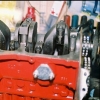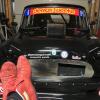Hello guys, I hope your knowledge can help me a bit ;)
First I'l try to describe how my car was before the modifications I've made in the last few weeks.
This guy is a bit of a mutt: it began as an austin mini 1000 from 1970 with a single hs2.
In the 90's the engine gave up and the way to rebuilt it was by using parts from a mini clubman (don't know the year...) and became a 1100 during that process.
To my knowledge, all parts are original except the engine itself.
So I had this:
- 1100cc engine
- hs2 carb with AN needle and red spring (I guess)
- standard exhaust (single box)
during the past couple of weeks I fitted a
- cooper freeflow manifold and a 1,75'' twinbox (all maniflow)
- a set of twin hs2's with EB's and blue springs (can't really tell the color but it is weaker than the one on the single hs2, so...)
The oil used on both carburettor setups is the same (power steering oil - don't really know the grade but it's heavier than standard su oil and lighter than engine oil)
The twins were all rebuilt including jets, butterflies, fuel bowl gaskets and valves, etc.
Using the standard choke setup (turning the jet nut 12 flats down), the engine fired right away and seemed fairly balanced.
Anyway, I proceeded to check the mixture on both carbs using a Gunsons Colortune (on cilinders 1 and 4) and afterwards balanced the carbs using a Gunsons Carb Balancer.
With no load, the engine works fine, rpm's rise nicely, etc. But when driving, there's a flatspot when the engine starts to pick up speed. Pretty noticeable when in 2nd gear, with the car almost stopped if i depress the acelerator slowly, the engine just bogs down; if I floor the accelerator, the engine rises and there is no problem.
Has I had also a pair of M needles, I thought I should give them a try and the problem got less severe. It still does it but now it's easier to drive in low gears.
With EB's or M's, in higher rpms there are no problems at all... This guy happily reaches 80 km/h in 3rd gear and 120 km/h in 4th with ease.
I also thought it could be the ignition timing, but as this car is a bit unique, I don't really know what the timing should be; anyway, with the engine running I turned the dizzy clockwise to find the maximum rpm and then turned a small bit counter-clockwise (so to make 250rpm less than maximum as I read here) and then proceeded to ajust mixture, balance carbs, etc all over again.
Is there a standard way to setup the ignition without just using the stated degree values on haynes manual or something?
In any case, I shot a small film using my cellphone while using the M's -->
Both accelerations are on 4th gear:
- on the first one there isn't any obvious problem
- on the second one... Well, I guess you'll be able to hear it almost die before it starts to rise.
If you can give any opinions, I would be very grateful.
Thank you everyone!




















